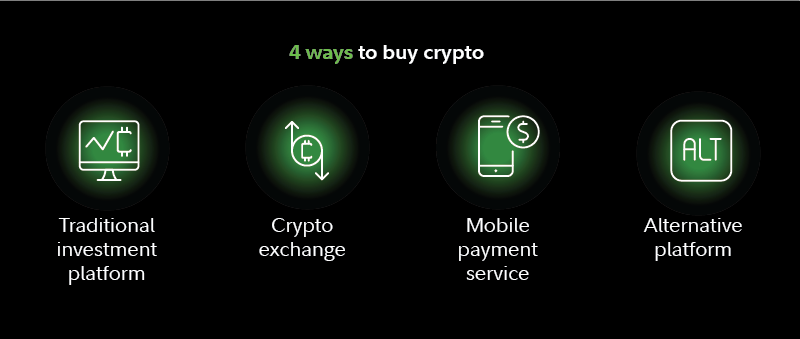You've learned what crypto is and how it works, and you're clear on the risks involved. You understand what it means to buy crypto (i.e., ownership of a purely digital asset). You also understand how blockchain technology works, accept that there is a strong possibility of short-term price fluctuations, and know what percentage of your portfolio you want to invest.
Now the question is: Which platforms allow you to buy crypto?
Currently, there are 4 main ways for investors to enter the market. Here's an overview of how they work.

Option 1: Traditional trading platform
Traditional trading platforms typically offer stocks, options, and other conventional assets. Many are now also offering crypto.
The buying process for crypto on these platforms is similar to buying a stock. Investors looking to enter the market at a specific price may benefit from using limit orders, where your order is only filled if it can be bought at the desired price. Those looking to enter the market as quickly as possible may consider using market orders, as long as you understand your order may not get filled at the exact price you want.
Traditional trading platforms have one key benefit compared to other options: simplified security.
For most of the other platforms discussed in this article, investors are often responsible for providing security for their own investments. This can be a complex process where a single error can result in losing access to investments forever.
Traditional trading platforms, however, take care of most of the security process for you. This often means investors only need to keep track of one password and one account, instead of keeping track of complex private keys. Those who don't have the time to learn crypto cybersecurity may find this route more manageable.
Of course, this may also be seen as a drawback for experienced investors. Because some traditional trading platforms don't currently enable withdrawing your crypto to a private or "cold" wallet, some buyers may feel that they don't have true control over their crypto.
Another potential drawback to consider: While traditional trading platforms don't typically charge commissions on buying and selling crypto, many currently charge a mark-up on your trading price.
Option 2: Crypto exchange
Crypto exchanges are platforms that only offer crypto. Let's briefly examine how the process works.
Step 1: Choosing an exchange Consider shopping around at multiple exchanges before jumping in, because they can vary in terms of both fees and security considerations.
First, let's talk about fees. Every exchange currently charges "maker fees" and "taker fees," both of which are typically listed on their website. Maker fees are charged when you place a limit order, which is where your order is only filled if you can buy it at your specified price or better. For example, if you place a limit order to buy bitcoin at $30,000, the platform will only fill your order at $30,000 or lower. Maker fees typically range from as low as 0.01% to as high as 0.30% of your total order value.
Taker fees are charged when you place a market order, which means you're buying at the next available price. Note that market orders do not guarantee your order will be filled at your desired price. For example, if you place a market order to buy bitcoin at $30,000, your order could be filled at a lower price or a higher price. Taker fees range from as low as 0.01% to as high as 0.40% of your total order value.
In addition to fees, investors might also want to consider security. Not every exchange is created equal, and because crypto is relatively new, certain exchanges are more reliable than others. Consider sticking with exchanges that rank in the top 10 for global trading volume. This may reduce your chances of running into scams (i.e., fake exchanges that don't allow you to withdraw your funds), low-volume markets (where your market orders are more likely to get filled at prices you don't want), and other unwanted events.
Step 2: Entering the market Most crypto exchanges will require users to submit some form of ID verification in order to create an account.
Once an account is created, you're given the option to link a bank account and transfer the funds you want to invest. From there, you have the option of entering the market via a limit or market order. As a reminder, crypto markets are volatile, so you may want to consider only transferring an amount you can afford to lose.
Step 3: Storing it safely Investors who buy crypto via a crypto exchange and decide to self-custody their coins are responsible for managing the security of their investments.
Those who don't have the time to learn about crypto cybersecurity or are still concerned about storage measures may want to consider buying through a brokerage platform instead.
Another point to be aware of is that many crypto exchanges offer the ability to stake or lend assets. This is a lot like earning interest by depositing money in a bank account. Instead of cash, however, you "deposit" your crypto. While staking or lending can offer eye-popping APRs (annual percentage rates), note that both are high risk. In the past, crypto platforms have crashed after promising unsustainable APRs, taking customers’ investments with them in the process.
Option 3: Mobile payment services
Investors can also enter the market through mobile payment apps they may already use.
These apps allow users to link a bank account and buy crypto directly from their smartphones, typically via a tab labeled "Crypto" on their mobile dashboards.
In exchange for the convenience, there are 2 notable drawbacks. First, some currently don‘t allow you to withdraw your crypto to a private or cold wallet. Once again, experienced investors may feel that they don't have true control over their coins.
Second, payment apps typically charge both a base fee and a spread on purchases. After all costs are considered, they are often more expensive than the 2 options discussed above.
Option 4: Alternative platforms
Some investors buy crypto with a credit or debit card, usually through an online platform specifically designed to support this process. These platforms can be convenient, but note that they typically involve high fees, with some services charging as much as 4.5% for card transactions.
Also remember that it's not uncommon for cryptocurrencies to rise or drop 10% in a single day. Buying with a credit card means taking on debt to purchase a highly volatile asset.
Elsewhere, you may have heard of Bitcoin ATMs, which are physical kiosks that allow you to buy crypto with a credit or debit card. These are owned by private businesses and generate revenue for their owners by charging transaction fees.
Bitcoin ATMs may also offer convenience, but they come with the same risks as online credit card-enabled platforms. They typically charge significantly higher fees than any other method.
Considerations for investing in cryptocurrency
To decide if crypto is right for your portfolio, be sure to first understand how it works. For example, you should be able to explain what a blockchain is and how it operates. It's also important to know why crypto fluctuates in value, and what that could mean for your investments in both the short and long term.
Once you understand key crypto concepts, make sure you can tolerate the risks. Remember that crypto is highly volatile, and may be more susceptible to market manipulation than securities. Crypto holders do not benefit from the same regulatory protections applicable to registered securities, and the future regulatory environment for crypto is currently uncertain. Crypto is also not insured by the Federal Deposit Insurance Corporation or the Securities Investor Protection Corporation, meaning you should only buy crypto with an amount you're willing to lose. This may help reduce portfolio impact in case prices drop significantly.


